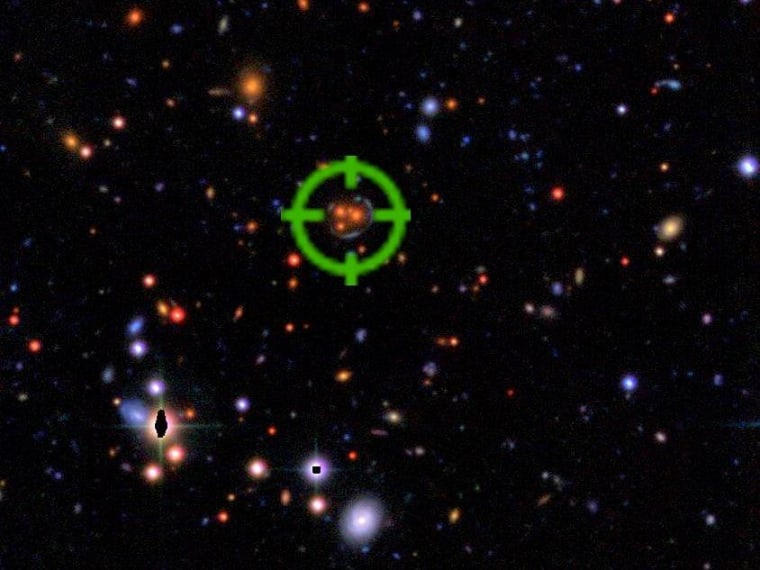Think you can find space warps? Astronomers have recruited thousands of citizen scientists to look for exoplanets, galaxies, moon craters and other cosmic curiosities — and now they need your help to go after one of the weirdest phenomena in space-time: gravitational lenses.
The Space Warps website gives Internet users the opportunity to sift through telescope images and spot galaxies so massive they bend the light rays that pass near them, like a lens. The venture could help crack some of the secrets of dark matter, the mysterious cosmic stuff that is more plentiful than the ordinary matter we see around us.
"Not only do space warps act like lenses, magnifying the distant galaxies behind them, but we can also use the light they distort to weigh them, helping us to figure out how much dark matter they contain and how it’s distributed," Oxford University physicist Phil Marshall, one of the leaders of the Space Warps research team, said in Wednesday's kickoff announcement. "Gravitational lenses help us to answer all kinds of questions about galaxies, including how many very low-mass stars such as brown dwarfs — which aren’t bright enough to detect directly in many observations — are lurking in distant galaxies."
Space Warps is the latest gem in Zooniverse's constellation of online citizen-science ventures — a constellation that also includes Planet Hunters, Galaxy Zoo, Moon Zoo and much, much more. The warp-hunting effort follows the model set by those other projects: Participants are given online training exercises to sharpen their lens-spotting skills, and then they're set loose to check sky survey images from the Canada-France-Hawaii Telescope.
"Computer algorithms have already scanned the images from the CFHT survey, but there are likely to be many more space warps that the algorithms have missed. Realistic simulated space warps are dropped into some images to train the volunteers how to spot them, and reassure people that they are on the right track,’ said Anupreeta More, project co-leader from Kavli IPMU in Tokyo.
Galaxy Zoo already has demonstrated that human eyes and brains are much better than automated computer software when it comes to recognizing the subtle characteristics of astronomical phenomena. Dozens of scientific papers have been spun off from Galaxy Zoo searches — including reports on the headline-grabbing blob of green gas known as "Hanny's Voorwerp."
Space Warps could well uncover similar curiosities. Warp-hunters will be able to discuss their finds with each other and with experts on the project's online forum, and even create computer models of their discoveries. A list of gravitational lenses will be published for amateurs and professionals to investigate further.
"Even if individual visitors only spend a few minutes glancing over 40 or so images each, that's really helpful to our research — we only need a handful of people to spot something in an image for us to say that it's worth investigating," said Oxford's Aprajita Verma, another leader of the Space Warps team.
So what are you waiting for?
More about gravitational lenses:
- Cosmic lenses find farthest galaxy yet
- Crazy cosmic lens focuses on dark matter
- Dark energy illuminated by cosmic lens
The Space Warps collaboration currently includes Phil Marshall, Aprajita Verma, Matthias Tecza, Chris Lintott, Rob Simpson (University of Oxford), Anupreeta More, Surhud More (Kavli IPMU), Amit Kapadia, Kelly Borden, David Miller, Arfon Smith (Adler Planetarium), Jean-Paul Kneib (EPFL Lausanne), Rafael Kueng, Prasenjit Saha (University of Zurich), and citizen scientists Elisabeth Baeten, Claude Cornen, Cecile Faure, Thomas Jennings, Stuart Lowe, Christine Macmillan, Julianne Wilcox and Layne Wright. Organizers say it is about to get a lot bigger.
Alan Boyle is NBCNews.com's science editor. Connect with the Cosmic Log community by "liking" the NBC News Science Facebook page, following @b0yle on Twitter and adding the Cosmic Log page to your Google+ presence. To keep up with NBCNews.com's stories about science and space, sign up for the Tech & Science newsletter, delivered to your email in-box every weekday. You can also check out "The Case for Pluto," my book about the controversial dwarf planet and the search for new worlds.
